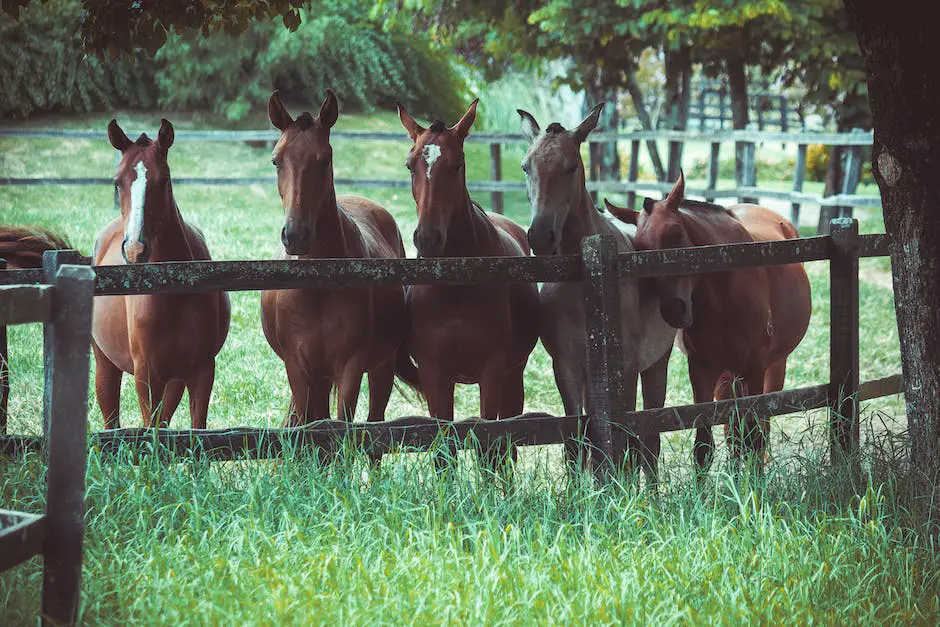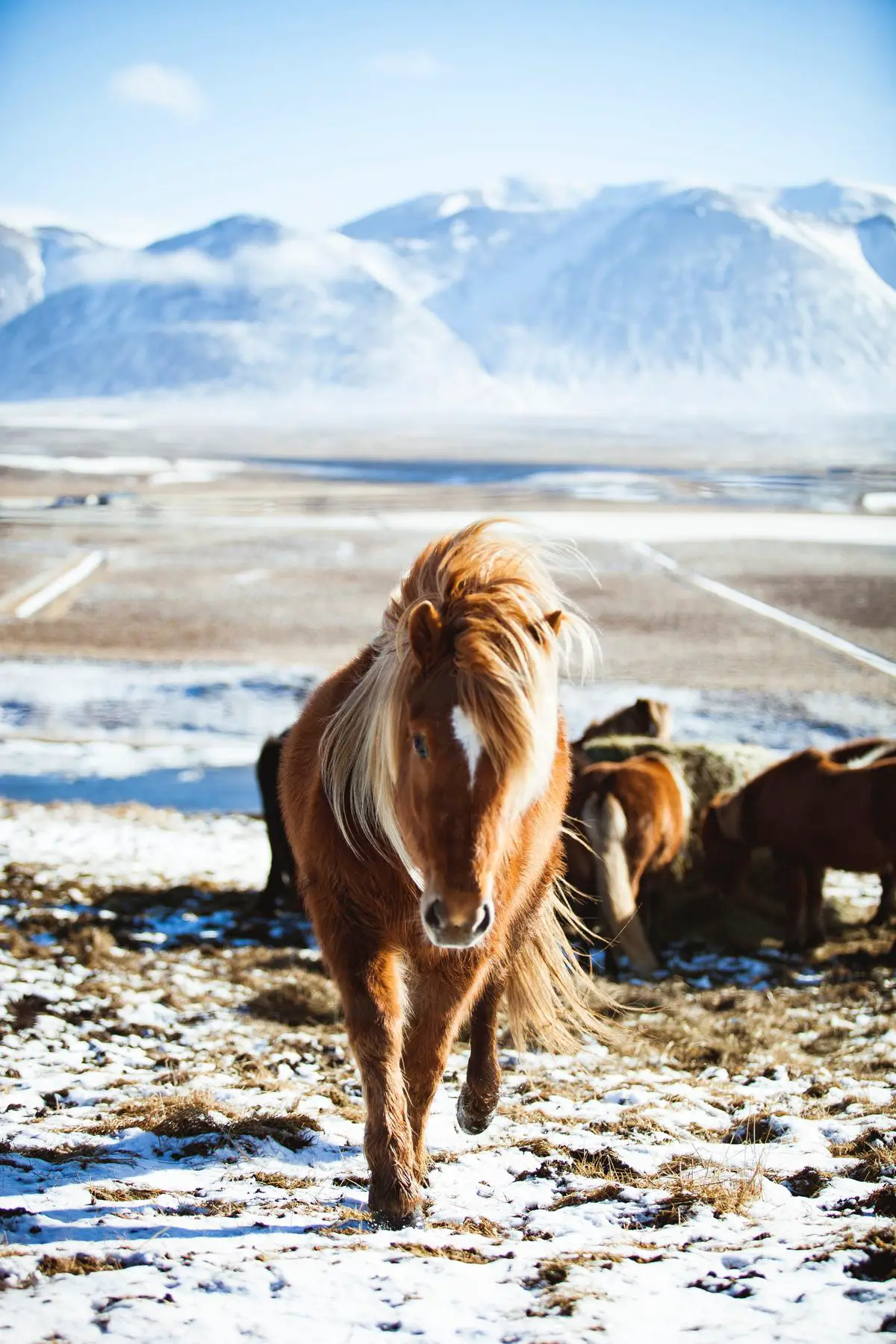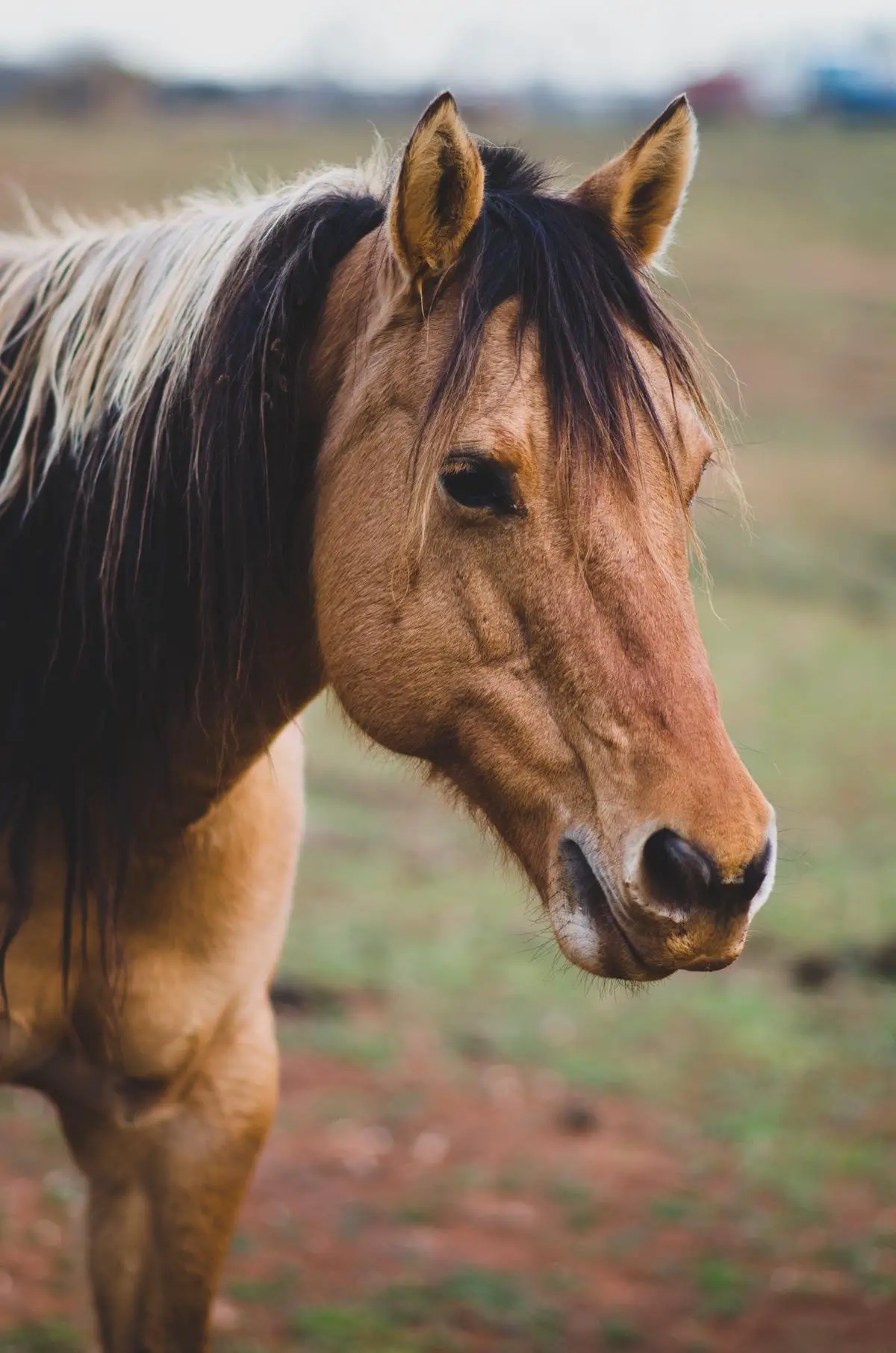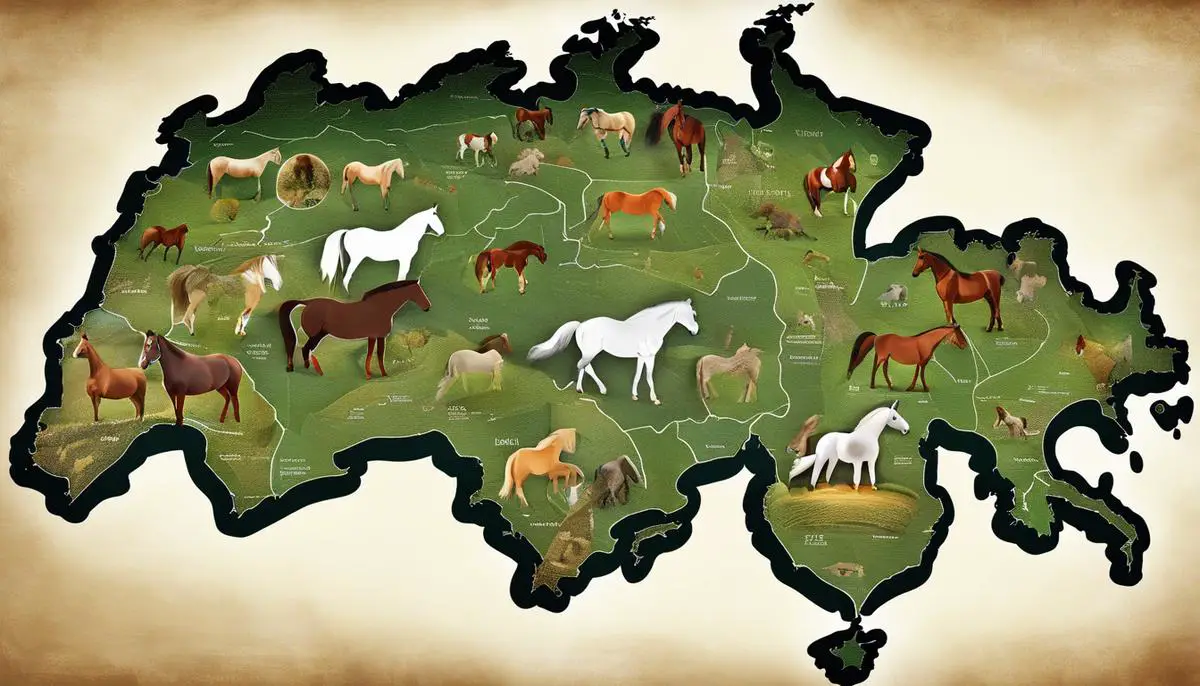The rich and diverse cultural history of Switzerland is intrinsically linked to equine traditions, with a vibrant horse industry that has inherently shaped both its socioeconomic landscape and global horse breeding practices. Delving back into the origins of horse breeding in this alpine region, it’s fascinating to follow the journey of how the local geography, customs, and economic necessities led to the cultivation of unique horse breeds aptly adapted to Switzerland’s distinct environment. From here, the pages of history turn to periods of war, where military needs shaped the evolution of this robust industry, giving preference to certain breeds renowned for their strength and reliability.
Table of Contents (Horspedia)
Origins of Horse Breeding in Switzerland
The origins and evolution of horse breeding in Switzerland offer a fascinating reflection of not only the nation’s rich history but also its deep-rooted values of preservation and precision. Since the Swiss Confederation’s inception in the 13th century, horses have played an indispensable role in transforming the alpine landscapes into a globally-revered heartland of horse rearing.
Scholars suggest horse breeding in Switzerland may trace back to the Bronze Age, when horses first arrived in Europe. Studies of archaeological finds and ancient artwork suggest the early Swiss integrated horses into their transportation and warfare infrastructure, signaling an early understanding of horse breeding principles.
However, large-scale horse breeding in Switzerland took its more structured form with the Romans, who used horses extensively in their military forces. Understanding the potential of horse breeding to enhance their strategic capabilities, the Romans introduced selective breeding techniques aiming to improve speed, temperament, and strength. Throughout the Middle Ages, the value of the horse remained unshaken, whether in agriculture, warfare, or transportation, reinforcing the significance of horse breeding.
The development of horse breeding in Switzerland was significantly influenced by the country’s treacherous topography. The steep, rugged mountains required a breed of horse possessing extraordinary strength and endurance. This led to the emergence of the Freiberger, one of the most critically-enduring horse breeds in the world, originating in the Jura Mountains of Switzerland in the 19th century.
As Swiss agriculture shifted increasingly toward dairy farming, the role of the horse evolved further, no longer merely as a means of transportation or a war asset. Equines transitioned into playing a substantial role as working farm animals, reviving interest in breeding to favor attributes such as pulling strength, docility, and hardiness.
Additionally, over time, societies developed a growing interest in equestrian sports which influenced horse breeding trends. Swiss Horse management adopted selectivity, preferring breeds suitable for sports such as dressage, show jumping, and three-day eventing. Hence emerged breeds such as the Swiss Warmblood, known for their athleticism, agility, and robustness.
Institutional support also played a significant role in shaping horse breeding in Switzerland. Federal Stud Farm of Avenches, for instance, was established in 1899 to maintain Swiss horse heritage. Through systematic breeding strategies and various public renderings, these institutions were key to enhancing horse quality, promoting Swiss equine culture, and overseeing regional breeding operations.
In conclusion, the evolution of horse breeding in Switzerland reflects socioeconomic changes, shifting agriculture practices, military requirements, and sporting preferences. Equally noteworthy is the country’s official engagement in maintaining and enhancing the breeding industry, testament to the prominent role horses played, and continue to play, in Swiss society. From trails winding through the Alps to major sporting arenas, Swiss-bred horses undeniably bear a stamp of excellence, a tribute to centuries of understanding, passion and precision garnered in their breeding.

The Influence of War on Switzerland’s Equine Industry
The Evolution of The Swiss Equine Industry: A Crucible of Conflict
The strategic role of the Swiss equine industry becomes more visible as we cross the threshold of the 20th century. Persistent geopolitical tensions and periods of conflicts played a considerable role in molding the Swiss equine landscape. The World Wars particularly marked a significant epoch in the history of the Swiss equine industry.
During World War I, the Swiss army shifted from reliance on infantry to the employment of cavalry and mounted artillery. Switzerland had a neutral stance but nonetheless had to be militarily prepared. The use of horses was exigent for logistics, artillery hauling, and maneuvering on the rugged terrain of Switzerland. This led to an increase in horse breeding, with a specific emphasis on breeds that had superior endurance, strength, and hardiness.
During the devastating World War II, Switzerland again stood neutral. However, the threat of invasion placed increased urgency on the importance of horse breeds adept for military and farming roles. The demographic shift of rural workers to urban areas, driven in part by wartime industrialization, necessitated horses to compensate for the decreased rural labor force. Meanwhile, the military required horses not only for artillery, but also for transportation of men and provisions as mechanized solutions were either unavailable or unreliable. These conditions precipitated into the promotion of Swiss military horse breeding programs and significantly increased demand for quality horse breeds.
Interestingly, the post-war period saw a decline in the use of horses in agriculture due to the advent of mechanization and tractors – a development one can see replicated globally. However, in Switzerland, this shift was not as rapid or complete as in other developed nations. The demanding alpine terrain and a cultural commitment to tradition meant that horses continued to play a role into the late 20th century and beyond.
Yet, the role of horses was further transformed from pure work animals to companions and equine sports participants. Public interest in equestrian events, in particular, propelled the equine industry forward once more. The Swiss thoroughbred breeding industry was invigorated by a rising interest in flat racing, jumping, and dressage competitions at the national and international level.
In conclusion, perhaps the most profound impact of conflict on the Swiss equine industry is that it has not only served as a catalyst for change but also facilitated continuity in a rapidly changing world. Through wars and periods of uneasy peace, horses have remained integral to Swiss culture, adapting to shifting requirements while retaining their core significance to the Swiss people. In fact, the Swiss equine industry’s adaptations to these conflicts and subsequent changes present an intriguing exploration of resilience.

Famous Swiss Horse Breeds
Swiss horse breeds have been indelibly linked to the country’s evolution, and their significance cannot be overstated. The horse breeds predominantly associated with Switzerland, besides the renowned Freiberger, are the Franches-Montagnes, Swiss Warmblood, and Swiss Thoroughbred.
Franches-Montagnes, also referred to as the Jura, is the last indigenous horse breed of Switzerland, perfectly suited for the demanding Swiss Alpine region. This breed’s significance lies in its versatility, strength, and endurance. Historically used as a workhorse, it served as an essential asset in the Swiss pastoral lifestyle.
The Swiss Warmblood, also known as the Einsiedler or the Swiss Half-bred, exhibits a rich tapestry of global influence. Starting with a local breed, the powerful and enduring Aargau, it was selectively bred with English Thoroughbreds, Arabians, and other continental European breeds. The end product is a superior horse breed, excellent for use in competitive and leisure equestrian pursuits.
The Swiss Thoroughbred, while not endemic to Switzerland, found a niche in the country due to growing interest in equestrian sports. They are celebrated for their speed, agility, and spirit.
World War I marked a significant turning point for the Swiss equine industry. The conflict catalyzed a transformation from pastoral, agricultural use to strategic military utility. Breeds were selected for their endurance, strength, and capacity for load-bearing. This warped the prevailing breeding objectives, noticeably influencing the gene pool.
Horses became instrumental during World War II, serving in logistical, transportation, and artillery hauling roles, primarily in terrains where mechanization was impractical, reinforcing the value of robust, durable breeds. Simultaneously, as Switzerland navigated wartime industrialization, there was a palpable rural to urban shift. Post-war mechanization and modernization gradually eroded the horse’s role in agriculture.
However, horses maintained importance within Switzerland. Unforgiving Alpine terrains still necessitated their use, and this characteristic landscape contributed to the continued survival and development of durable, strong horse breeds. The transformation of horses’ function from laboring work animals to companions and sporting aids within this timeframe underscored the versatility and adaptability of these breeds.
The Swiss equine industry received a fresh impetus with the surge in equestrian events. Swiss thoroughbred breeding took flight, reinforcing Switzerland’s established horse breeding tradition, and solidifying its place on the global equestrian stage.
In conclusion, Swiss horse breeds hold historical significance as pillars of the nation’s agrarian and wartime past, while evolving to remain paramount in the country’s modern socio-economic landscape. Their resilience is a testament to both the horses and the Swiss people’s dedication to preserving indigenous horse breeds, exemplifying the symbiotic relationship woven throughout centuries of Swiss history. It is integral to recognize and celebrate these horse breeds, for they embody the Swiss spirit of resilience, adaptability, and heritage.

Photo by dominostudio on Unsplash
Modern Developments in Swiss Equine Industry
Delving into the annals of Swiss equine history unveils the unique breeds native to the country, each with its distinctive characteristics and uses. Chief amongst these are the Franches-Montagnes, Swiss Warmblood, and Swiss Thoroughbred breeds.
The Franches-Montagnes, also known as the Freiberger, represents the last light draft horse breed in Europe. Hailing from the Franches-Montagnes region, this breed emerged from necessity during World War I. Exemplified by a balanced temperament, robustness, and versatility, these horses were crucial in logistics during the war and substantially influenced the equine industry during the early 20th century.
The Swiss Warmblood, predominantly used for show jumping and formative equestrian sports, traces its lineage back to heavier horses crossbred with Thoroughbreds and English Half Bloods. Long-held breeding practices have resulted in a horse breed marked by powerful movement, speed, agility, and unique aesthetic qualities.
The Swiss Thoroughbred is indeed a distinct entity from its English counterpart. Albeit less commonly bred in Switzerland, these sleek, agile horses uniquely combine selective traits from the Arabian and English Thoroughbreds, designed for racing and high-energy equestrian sports.
World War II, much like its predecessor, had a significant impact on horse usage and breed preferences. Swiss horse breeds, notably Franches-Montagnes and Swiss Warmblood, adept at swift maneuvering even in treacherous terrains, intended to serve military and farming purposes, were in high demand.
The post-war era, however, conjured a different trajectory for horses in agriculture, substantially redirected due to swift mechanical automation. This shift, crucially from rural to urban, relegated the role of horses as farm workers progressively less significant while elevating their status as sporting and companion animals.
Notwithstanding the daunting alpine terrains, where machinery often fell short, horses continued to perform an indispensable role. This led to a maintained demand for the durable Swiss breeds, alias symbols of hardiness.
The transformation of horses from working beasts to revered companions further spurred a mounting interest in the equine sports domain, invigorating the Swiss thoroughbred breeding industry. This evolution continues to sculpt the Swiss equine industry, catalyzing advancements in veterinary sciences, genetic research, and horse welfare.
We, the scientists studying the Swiss equine industry, relentlessly follow these trends, tracing patterns amidst the transition, metamorphosing the function of horses from incrementally utilitarian to increasingly normative. Balancing historical significance with modern relevance, we chart the future of the venerable Swiss horse, embedded not just in Swiss culture, but flowing within the every heartbeat of this resilient country.

Photo by sethlfink on Unsplash
Switzerland’s Contribution to Global Equine Research
While we have laid substantial groundwork regarding the historical context in our understanding of Switzerland’s equine influence, it’s crucial now to engage with the country’s impact on the knowledge gains in equine science and welfare. Switzerland’s dedication to rigorous scientific inquiry and improvement has shaped its contributions significantly.
Horse genetic testing, in particular, has been an area where Swiss scientists have significantly influenced our understanding. Switzerland’s Institute of Animal Genetics, Nutrition and Housing at the University of Bern was instrumental in identifying the mutation responsible for Polysaccharide Storage Myopathy (PSSM) in certain horse breeds. This breakthrough offered profound insights into the symptoms and management strategies for affected horses, leading to significantly improved welfare and performance.
The Swiss National Stud Farm in Avenches has been pivotal in contributing to ethological research, investigating horse behavior for better welfare-oriented housing solutions. Recognizing the impact of social interactions on horse welfare, researchers from the Federal Institute of Technology in Zürich revealed that horses in free-roaming herds communicate more efficiently and display less aggressive behaviors. This study underpins the movement shifting horse housing strategies from solitary to group stabling, positively impacting horse welfare worldwide.
Furthermore, the Swiss have formed progressive legislation regarding ethical animal treatment. The nation’s Animal Welfare Act, designed to protect the dignity of the creature, has been replicated in various forms worldwide. This law offers specific mandates regarding proper stabling, pasture time, and companionship for horses, highlighting the interaction between legal standards and scientific understanding.
Research and applications in equine therapy conducted in Switzerland have presented an innovative perspective on horses’ role in human wellbeing. Equestrian therapy, supported by rigorous scientific validation, is now endorsed by mainstream medical and psychological therapies. Swiss researchers continue to elaborate on the therapeutic influence, examining horses’ impact on human physical and mental health, emphasizing the importance of these animals beyond their traditional roles.
The Swiss also greatly contribute to orthopedic studies, delving into equine biomechanics to enhance our understanding of conditions like laminitis and navicular disease. The University of Zurich’s Equine Department is exploring cutting-edge therapies to treat bone and joint disorders, fostering an international collaboration to advance equine orthopedic knowledge.
Switzerland’s influence goes beyond the aforementioned fields encompassing innovation in equine nutrition, reproductive health, performance medicine, genetic research, and wildlife conservation. These scientific advancements not only stem from a deep-felt respect for horses intertwined with Swiss society but also from the understanding that better knowledge transpires into improved equine welfare. The willingness to fund such research and share findings globally is a testament to Switzerland’s commitment to this cause.
In essence, Switzerland’s rich equine history coupled with its pursuit of scientific excellence offers a unique amalgamation that has extensively informed equine sciences and welfare. Its decisive role played in the evolution of modern equine practices resonates around the globe, establishing Switzerland’s prestigious position in equine academia and beyond. The country’s impressive panorama of equine-based knowledge advances, paired with its preservation of native horse breeds and evolving breed characteristics, continues to enhance the quality of life of these magnificent creatures, influencing tomorrow’s world.

Switzerland’s influence on equine development has seen a dynamic shift with modern advancements and a renewed focus on the industry in the 21st century. The country’s strides in equestrian sports, evolving breeding practices, and innovative use of horses in therapeutic fields showcase its progressive and multifaceted equine sector. However, like any industry, the Swiss equine sector faces challenges, including those posed by international trade, climate change, and the onward march of modernity. Yet, Switzerland’s resilient nature and love for horses are effectively weaving equine welfare into the heart of its responses. This deeply entrenched respect for equines continues to fuel the country’s key contributions to global equine research, enabling a greater understanding of horse behavior, nutrition, and well-being, thus securing its place in the annals of global equine history.

